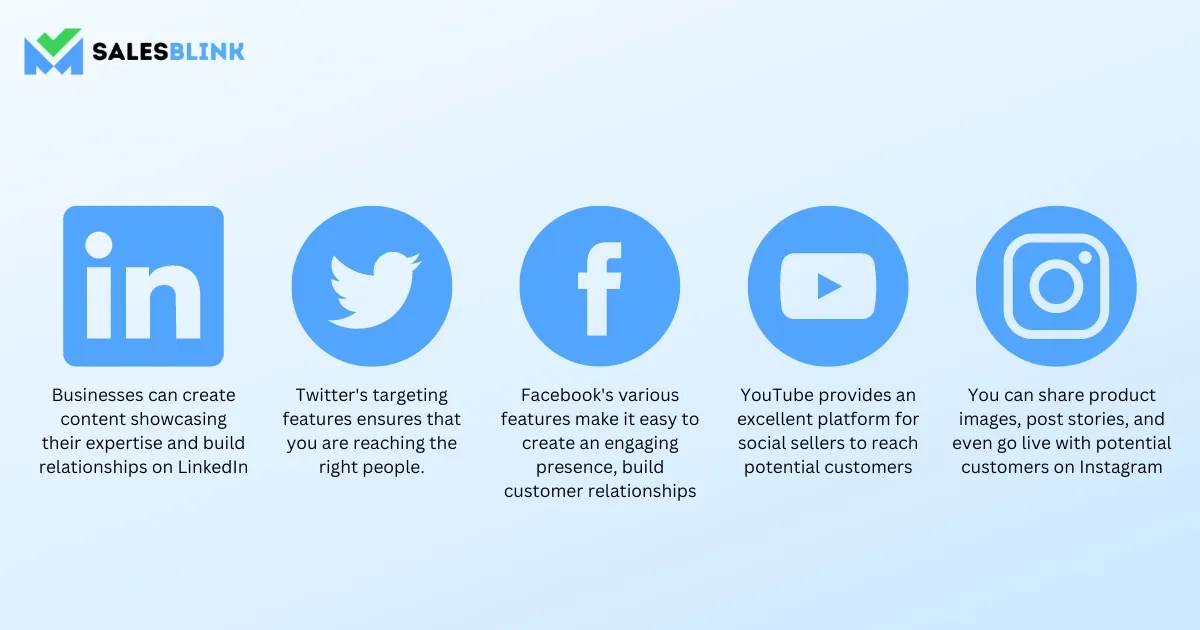Do you know that 61% of those who engaged in social selling reported immense revenue growth? If you are looking for ways to increase the revenue of your business, you’re at the right place. In this blog post, we’ll give you the ultimate social selling tips on getting started and increasing your revenue.
We’ll discuss leveraging social media, creating engaging content, and building relationships with potential customers. We’ll also share some practical advice on optimizing your social media presence and maximizing your sales. So, if you’re ready to take your business to the next level, read on for the ultimate social selling tips!
Table of Contents
- What Is Social Selling?
- What Are The Benefits Of Social Selling?
- What Are The Best Platforms For Social Selling?
- Social Selling Tips To Share With Your Team
- 1. Optimize Your social media profiles
- 2. Build relationships before selling
- 3. Focus on the comments section
- 4. Share success stories
- 5. Add value before you sell
- 6. Engage in relevant online communities
- 7. Know about the competitors
- 8. Give more than you receive
- 9. Stay active & be consistent
- 10. Take time to build the foundation
- 11. Keep it real
- 12. Nurture your prospects
- 13. Create a content schedule
- 14. Do your research
- 15. Build credibility by sharing success stories
- 16. Subscribe to blogs
- 17. Continue the conversation on other channels
- 18. Don’t neglect existing customers
- 19. Seek referrals
- 20. Update profiles
- 21. Align With What Works
- 22. Track results and make adjustments
- 23. Be patient
- FAQs
What Is Social Selling?
Social selling is a modern technique for sales that leverages social media to reach potential customers and build relationships with them. It involves using platforms like LinkedIn and Twitter to identify, engage, and nurture leads.
Unlike traditional sales, social selling focuses on building relationships and fostering trust with prospects. It is less about direct pitching than providing value and building connections.
This can include things like offering helpful advice and sharing relevant content to their industry. By providing value, salespeople can increase the chances of turning a prospect into a customer. Additionally, social selling can help stay in touch with existing customers and build loyalty. Overall, it effectively showcases your expertise, increases brand visibility, and grows your business.
What Are The Benefits Of Social Selling?
Before looking at the social selling tips, let’s look at the benefits:
1. Helps increase brand visibility
With social selling, prospects get to know about your brand and what you have to offer.
2. Gets you high-quality leads
As you have plenty of information about quality leads on social media, it is easier for you to reach out to them. Plus, mutual connections will accelerate the whole process.
3. Increases website traffic
As your brand visibility increases and the company content gets more shares, there is a high chance of an increase in website traffic. Then increased web traffic is definitely a benefit for every business functioning online.
4. Shortens sales cycle
It is easier to build relationships with prospects with the help of social media, and you will look credible to the prospect faster, making you close the deal in a shorter period.
What Are The Best Platforms For Social Selling?

For B2B sales, the best social networks include the following:
- LinkedIn – With LinkedIn, businesses can create content showcasing their expertise and building relationships with potential customers. It helps build thought leadership. Businesses can also use LinkedIn to research their target market and gather insights into their customer behavior.
- Twitter – You can use Twitter’s targeting features to reach the right audience. By targeting users based on their location, interests, or other criteria, businesses can ensure that their messages reach the right people.
- Facebook – Facebook’s various features make it easy to create an engaging presence, build customer relationships, and share product information. Furthermore, the ability to track customer interactions and measure the success of campaigns makes it a powerful tool.
- YouTube – With its vast user base, YouTube provides an excellent platform for social sellers to reach potential customers. You can also use YouTube for social selling by engaging with viewers, which includes responding to comments.
- Instagram – With Instagram, you can share product images, post stories, and even go live with potential customers. Using hashtags, post comments, and direct messages, you can also use the platform to find customers interested in what you’re selling.
Social Selling Tips To Share With Your Team
Here are some super-effective social selling tips,
1. Optimize your social media profiles

To succeed at social selling, you need to optimize your social media profiles for social selling. First, make sure that your profile information is accurate and up-to-date.
This includes your contact information, job title, and company name. You should also have a professional headshot and a link to your website. Next, make sure you are active on social media. Post regularly about your product or service topics and engage with your followers. Finally, use your profiles to showcase your industry knowledge and expertise. Share stories and insights that will show potential customers you are an authority in your field. With the right optimization efforts, you can create powerful social media profiles that will help you to succeed.
2. Build relationships before selling
The key to successful social selling is getting to know your target audience and building trust before making a sale. Start by identifying people in your target market and engaging with them on social media.
Share helpful content, answer their questions, and comment on their posts. This will help you build relationships and demonstrate your expertise. You can also use social media listening tools to find conversations about your industry so that you can join in and provide valuable insights.
Once you build relationships, you can start subtly introducing your products and services. But, again, stay focused on helping the customer, and don’t be too pushy. If done correctly, social selling can effectively build relationships with customers before you start selling.
3. Focus on the comments section

Regarding social selling, the comments section can be a gold mine. It’s an effective way to interact with customers and build relationships. By responding to comments and engaging with the people who have interacted with your content, you can show that you value their opinion and demonstrate your expertise in your industry.
Additionally, responding to comments can provide valuable insights into what your customers are looking for and help you better tailor your offerings to meet their needs. The comments section is also great for showcasing your brand’s personality and building trust with potential customers. Whether through witty banter or informative dialogue, you can use the comments section to show that you’re not just a faceless business but a real person who cares about their customers. So, when it comes to social selling, don’t overlook the power of the comments section!
4. Share success stories
Success stories can help build credibility and establish trust with potential customers, which is essential for any successful sales professional. In addition, by sharing success stories, you can provide an example of what is possible with your product or service. This can be a powerful motivator for prospects to take action and buy your product.
Additionally, you can use success stories to demonstrate how other customers have used your product or service and how it has improved their lives. This helps to create an emotional connection with your potential customers and encourages them to take the next step. Finally, success stories provide valuable insights into the customer journey and can be used to optimize your sales process and improve your overall results.
5. Add value before you sell

This is one of the best social selling tips for you. Before you start selling, adding value to your interactions is important. This means providing advice, relevant industry insights, and useful resources to the people you are trying to sell to. By doing this, you are showing that you care about the customer and their needs rather than just trying to make a sale. This will help build trust and make customers more likely to buy from you in the future. Additionally, it will help you stand out from other sellers, as customers will appreciate your willingness to go the extra mile and provide value before making a purchase. So, if you want to be successful with social selling, remember to add value before you sell.
6. Engage in relevant online communities
One of the best ways to engage in social selling is to join relevant online communities. These comprise of like-minded people who share similar interests and goals. By engaging in these communities, you can establish yourself as an expert in your field and build relationships with potential customers. You can also use these communities to learn more about your target audience’s needs and get feedback on your products and services. Finally, these communities can give you valuable insight into the latest trends in your industry, which can help you stay ahead of the competition. So, if you’re serious about social selling, engage in relevant online communities.
7. Know about the competitors

When it comes to social selling, it’s essential to understand your competitors. Knowing what your competitors are doing will help you create a more effective strategy for reaching your target audience. It’s essential to keep track of their social media presence and what type of content they’re sharing. It can also be helpful to see how they engage with customers and respond to feedback. Additionally, you should look at what kind of products or services they offer and their pricing and promotional strategies. By understanding your competitors, you’ll be able to develop an outstanding social selling strategy.
8. Give more than you receive
It’s important to remember that social selling isn’t just about making the sale; it’s also about building relationships with potential customers. To do this, it’s essential to give more than you receive. That means providing valuable content and advice, engaging with potential customers on social media, and answering their questions and concerns. It takes more effort and time but will pay off in the long run. Customers will be more likely to trust you and purchase from you when they know you are genuinely interested in helping them rather than just trying to make a sale.
9. Stay active & be consistent

You’ll need to stay active and consistent to succeed in social selling. That means posting regularly on various social media platforms, engaging with your followers, and showing that you understand their needs. It also means staying up to date with industry trends so that you can provide relevant and helpful information to your followers. And finally, it means being responsive to messages and inquiries from potential customers. If you can do all of this, you’ll be well on becoming a successful social seller.
10. Take time to build the foundation
It’s important to remember that social selling is a marathon, not a sprint. To be successful, you need to take the time to build the foundation for your social selling efforts. This means researching your target audience, developing a comprehensive strategy, and creating content that will engage your followers. It’s also important to focus on building relationships with your followers rather than just trying to make a sale. Show your followers that you’re an expert in your field and are eager to help them. By taking the time to build the foundation of your social selling strategy, you will be able to create a successful long-term plan that will drive sales.
11. Keep it real

Social selling is a powerful tool for connecting with potential customers, but it can only be successful if you do it in an authentic and genuine way. To keep social selling real, it’s essential, to be honest about who you are and what you have to offer. Don’t use aggressive sales tactics or false promises; instead, focus on building customer relationships and trust. It’s also important to be active and engaged on social media. Post regularly, respond to comments, and show your customers you care about their needs.
By keeping your social selling real, you can build a strong relationship with your customers that will last for years to come.
12. Nurture your prospects
It’s important to remember that social selling is not just about pushing products or services. To truly benefit from social selling, you need to nurture your prospects. This means building relationships with leads and potential customers, engaging with them on social media, and providing helpful information to help them make informed decisions. It also means being authentic and genuine in your interactions. People can sense when someone is just trying to make a sale, which can be a major turn-off.
By nurturing your prospects and making genuine connections, you can create long-term relationships with customers and increase your chances of making sales.
13. Create a content schedule

Creating a content schedule is integral to any successful social selling strategy. A content schedule should include the type of content you plan to post, when you will post it, and how often you will post it. When creating your content schedule, it’s essential to consider the needs of your target audience. Once you have a clear idea of what type of content your audience wants, you can create a content schedule tailored to their needs. Be sure to include a mix of educational, entertaining, and promotional content to appeal to a wide range of potential customers.
Finally, be sure to track the performance of your content so that you can adjust your schedule as needed. With a well-crafted content schedule in place, your social selling strategy will surely get noticed.
14. Do your research
If you want to make the most of your social selling, it’s essential to do your research. First, figure out your target audience and which social media platforms they use most frequently. Next, look for trends in their interests and activities and what type of content resonates with them. Understanding your customer’s needs, wants and preferences will help you create content that’s more likely to engage them. Additionally, research can provide valuable insights into your competition, allowing you to gain an edge in the market and increase your sales. Therefore, doing your research is essential for creating effective social selling strategies, and it’s an investment that will pay off in the long run.
15. Build credibility by sharing success stories

One of the best ways to build credibility is to share customer success stories. You can share them on various social media channels, as well as your website and blog. It is essential to make sure that success stories are relevant to your target audience and showcase the value of your product or service. When customers share their positive experiences, it builds trust and creates an emotional connection with potential customers. Sharing success stories also serves as an endorsement for your business and shows potential customers that you are a reliable provider. It is a good social media marketing strategy. By sharing success stories, you can build credibility and trust with your target audience and increase your chances of making a sale.
16. Subscribe to blogs
You can stay up-to-date on the latest trends and strategies by subscribing to quality blogs. This will help you stay ahead of the competition and be more effective in your social selling. Plus, reading industry-specific blogs can give you a better understanding of the market and your target audience. This knowledge can help you craft more effective messages and develop meaningful relationships with potential customers.
Overall, subscribing to blogs can help you stay motivated and inspired. Reading success stories and advice from industry experts can give you the confidence to take risks and reach new heights.
17. Continue the conversation on other channels

To be successful, businesses need to go beyond having the conversation on one channel. For example, if you’ve been engaging with customers on Facebook, see if there are any opportunities to connect with them on other platforms like Twitter, LinkedIn, or even email. You can also use offline channels like direct mail or in-person events to further engage customers and potential customers. You can reach more people by continuing the conversation on multiple channels and building stronger customer relationships.
18. Don’t neglect existing customers
When it comes to social selling, it’s easy to focus on acquiring new customers, but that shouldn’t come at the expense of existing customers. It’s important to remember that existing relationships can be just as valuable as new ones, and neglecting them could harm your business.
When engaging with existing customers on social media, ensure you provide relevant and useful content. This could include information about new products and services, discounts, or tips and advice. You should also thank them for their loyalty and interact with their comments and posts. Not only will this help to strengthen your relationships with existing customers, but it will also help to demonstrate to prospective customers that you care about your customers and value their feedback.
19. Seek referrals

Referrals are a great way to build trust and credibility with potential customers, as well as to get access to new prospects. A referral from a trusted source can be much more effective than cold outreach or other marketing tactics. To get referrals, start by reaching out to your existing network. Ask them for introductions to potential customers. You can also reach out to influencers in your industry and ask them to share your product or services with their followers. Finally, you can use social media to connect with prospects interested in what you offer. By doing this, you’ll be able to build relationships with people in your target market without having to rely on cold outreach.
20. Update profiles
It’s essential to ensure that your social media profiles are up-to-date and well-managed to maximize your chances of success. Here are a few tips to help you improve your social selling strategy:
- Update your profile photo and bio to reflect your current brand image.
- Keep your content fresh by posting regularly and engaging with followers.
- Take advantage of tools like hashtags and stories to reach a wider audience.
- Take the time to respond to messages and comments as promptly as possible.
- Monitor analytics to understand what type of content resonates best with your audience.
Updating your social media profiles ensures you’re giving yourself the best chance of success. That way, you can focus on building relationships with potential customers and finding new ways to grow your business.
21. Align with what works

To succeed in social selling, aligning yourself with what works is essential. Here’s what all can help you hit the bullseye:
- Identify your target audience. Know who you’re trying to reach and what they’re interested in.
- Establish yourself as an expert in your field. Share useful and relevant content that your target audience will find valuable.
- Become an active member of the conversation. Engage with people, answer questions, and offer advice.
- Leverage relationships to grow your network. Connect with influencers and other industry professionals to expand your reach.
- Personalize your outreach. Show prospects that you understand their needs and are willing to help them.
By following these tips, you’ll be well on your way to becoming a successful social seller.
22. Track results and make adjustments
It’s essential to track the performance of your social selling efforts and make adjustments accordingly. You need to track key metrics such as engagement rate, follower growth, lead generation, and conversions to do this. Once you understand your performance well, you can start making adjustments to improve your social selling. This could involve changing your content type, making sure your messages are more targeted, or experimenting with different platforms. It’s also essential to stay up-to-date with the latest trends in social selling so that you can stay ahead of the competition.
23. Be patient

To improve your social selling, you must be willing to commit to the process and put in the effort it takes to build relationships with potential customers. It would help if you were patient, listened to their needs, and provided value and advice. This approach will help you develop trust and loyalty with customers, which will lead to more sales in the long run. It would help if you were patient when gauging results from your social selling efforts. It can take some time for your efforts to bear fruit, and you shouldn’t expect immediate returns. However, if you remain patient and consistent, you will eventually reap the rewards of your hard work and dedication.
With this we come to an end of the social selling tips.
Set Out On Your Journey With Our Social Selling Tips
Social selling is an effective way to increase revenue and build relationships with potential customers. By leveraging the power of social media, you can target the right audience and find qualified leads. With the right active social media strategy, tools, and techniques, you can take advantage of social selling and grow your business. In addition, it is essential to remember that social selling is a long-term process that requires consistency and commitment. Hopefully our social selling tips give you the right inputs.
FAQs
To do social selling effectively, you need to start by creating an engaging social media profile showcasing your product or service. Then, start interacting with potential customers. Share interesting blog posts or videos, and look for opportunities to engage in conversations.
The best platforms for social selling are LinkedIn, Twitter,
Facebook, YouTube, Instagram. Though each of them has different approaches, you can get great results by creating a perfect mix of all of them. Just use them right to see results.
Social selling helps increase brand visibility, gets you high-quality leads, increases website traffic, and shortens your sales cycle considerably. This way, it can work in your favor and help you close more leads effectively.

Leave a Reply